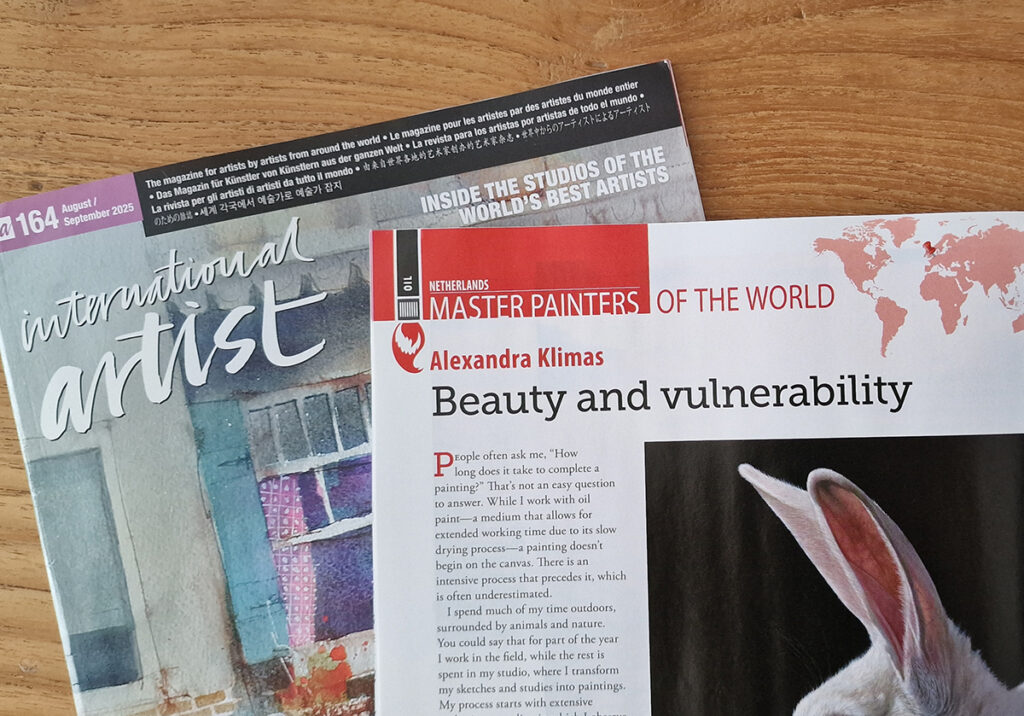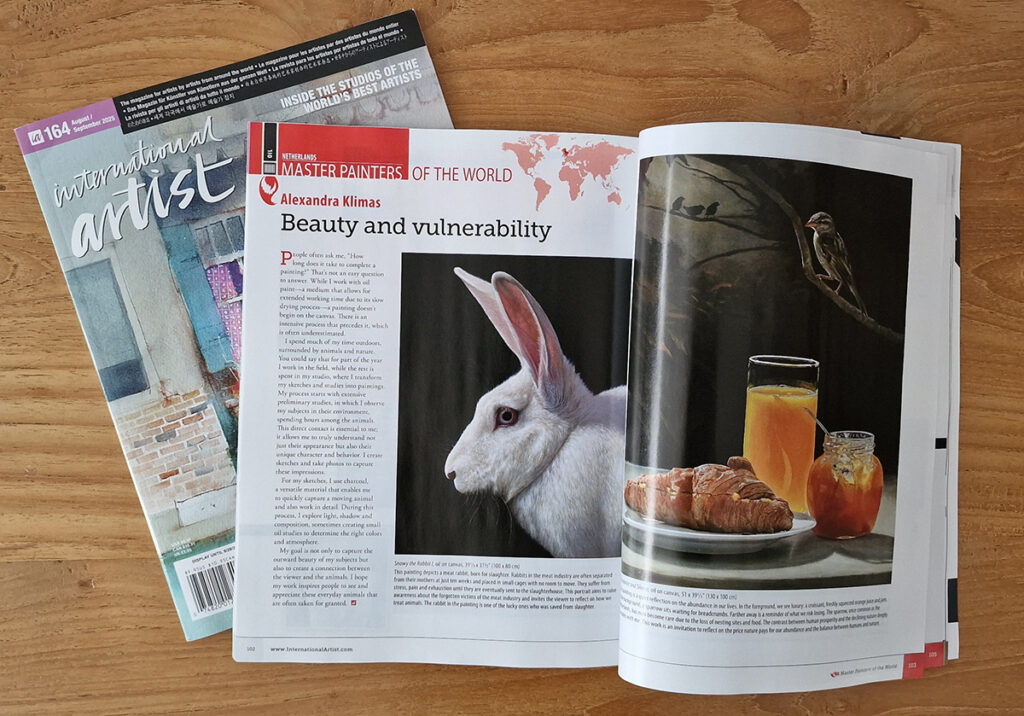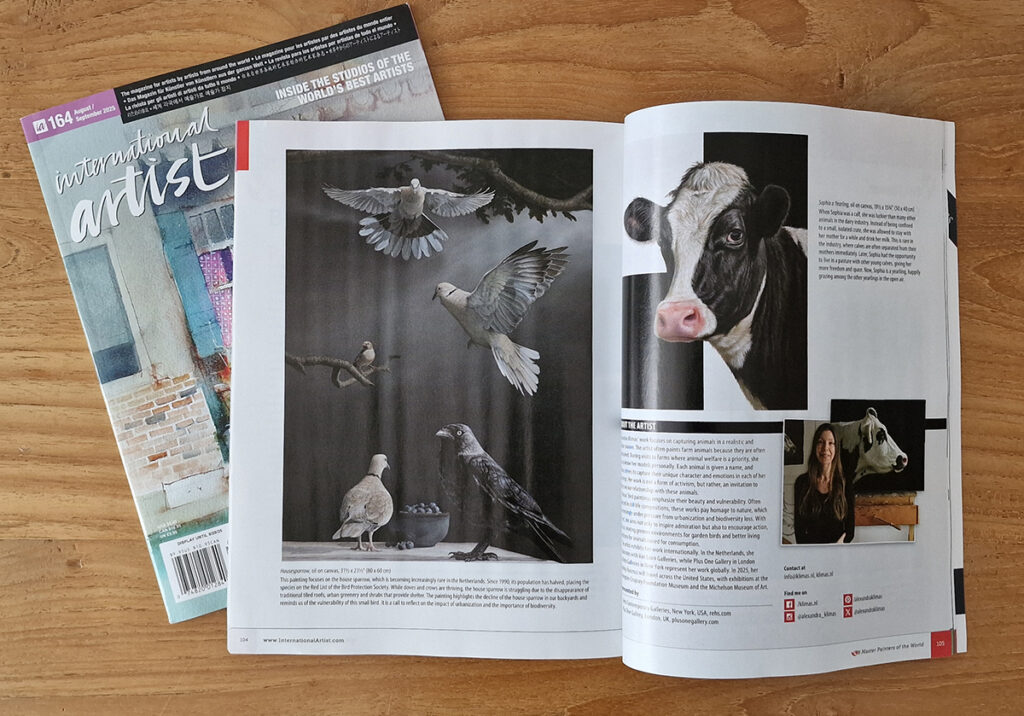I am honored to have won the International Artist Award of Excellence with my bird painting “House Sparrows Wait for Breadcrumbs” during the 17th International ARC Salon. Four of my paintings have been published in International Artist Magazine (August/September 2025, issue 164) in the section “Master Painters of the World”.

The winning painting itself is not included in the publication; instead, my other bird painting “Housesparrow” was selected, as it is also on view at the Michelson Museum of Art in Texas during the magazine’s release period, as part of the group exhibition Birds in Art on Tour.
Publication date: August/September 2025 Issue: 164
Publication medium: International Artist Magazine
Section: Master Painters of the World Pages: 102–105

MASTER PAINTERS OIL OF THE WORLD
Alexandra Klimas
Beauty and vulnerability
People often ask me, “How long does it take to complete a painting?” That’s not an easy question to answer. While I work with oil paint—a medium that allows for extended working time due to its slow drying process—a painting doesn’t begin on the canvas. There is an intensive process that precedes it, which is often underestimated. I spend much of my time outdoors, surrounded by animals and nature. You could say that for part of the year I work in the field, while the rest is spent in my studio, where I transform my sketches and studies into paintings. My process starts with extensive preliminary studies, in which I observe my subjects in their environment, spending hours among the animals. This direct contact is essential to me; it allows me to truly understand not just their appearance but also their unique character and behavior. I create sketches and take photos to capture these impressions. For my sketches, I use charcoal, a versatile material that enables me to quickly capture a moving animal and also work in detail. During this process, I explore light, shadow and composition, sometimes creating small oil studies to determine the right colors and atmosphere. My goal is not only to capture the outward beauty of my subjects but also to create a connection between the viewer and the animals. I hope my work inspires people to see and appreciate these everyday animals that are often taken for granted.

Snowy the Rabbit I, oil on canvas, 391/3 x 31½” (100 x 80 cm)
This painting depicts a meat rabbit, born for slaughter. Rabbits in the meat industry are often separated from their mothers at just ten weeks and placed in small cages with no room to move. They suffer from stress, pain and exhaustion until they are eventually sent to the slaughterhouse. This portrait aims to raise awareness about the forgotten victims of the meat industry and invites the viewer to reflect on how we treat animals. The rabbit in the painting is one of the lucky ones who was saved from slaughter.
Abundance and Silence, oil on canvas, 51 x 391/3” (130 x 100 cm)
This painting is a quiet reflection on the abundance in our lives. In the foreground, we see luxury: a croissant, freshly squeezed orange juice and jam. In the background, a sparrow sits waiting for breadcrumbs. Farther away is a reminder of what we risk losing. The sparrow, once common in the Netherlands, has now become rare due to the loss of nesting sites and food. The contrast between human prosperity and the declining nature deeply resonates with me. This work is an invitation to reflect on the price nature pays for our abundance and the balance between humans and nature.

Housesparrow, oil on canvas, 31½ x 23½” (80 x 60 cm)
This painting focuses on the house sparrow, which is becoming increasingly rare in the Netherlands. Since 1990, its population has halved, placing the species on the Red List of the Bird Protection Society. While doves and crows are thriving, the house sparrow is struggling due to the disappearance of traditional tiled roofs, urban greenery and shrubs that provide shelter. The painting highlights the decline of the house sparrow in our backyards and reminds us of the vulnerability of this small bird. It is a call to reflect on the impact of urbanization and the importance of biodiversity.
Sophia a Yearling, oil on canvas, 19½ x 15¾” (50 x 40 cm)
When Sophia was a calf, she was luckier than many other animals in the dairy industry. Instead of being confined to a small, isolated crate, she was allowed to stay with her mother for a while and drink her milk. This is rare in the industry, where calves are often separated from their mothers immediately. Later, Sophia had the opportunity to live in a pasture with other young calves, giving her more freedom and space. Now, Sophia is a yearling, happily grazing among the other yearlings in the open air.
ABOUT THE ARTIST
Alexandra Klimas’ work focuses on capturing animals in a realistic and lifelike manner. The artist often paints farm animals because they are often overlooked. During visits to farms where animal welfare is a priority, she gets to know her models personally. Each animal is given a name, and Klimas strives to capture their unique character and emotions in each of her paintings. Her work is not a form of activism, but rather, an invitation to reflect on our relationship with these animals. Klimas’ bird paintings emphasize their beauty and vulnerability. Often depicted in still life compositions, these works pay homage to nature, which is increasingly under pressure from urbanization and biodiversity loss. With her art, she aims not only to inspire admiration but also to encourage action, such as creating greener environments for garden birds and better living conditions for animals raised for consumption. The artist exhibits her work internationally. In the Netherlands, she collaborates with Van Loon Galleries, while Plus One Gallery in London and Rehs Galleries in New York represent her work globally. In 2025, her painting Huismus will travel across the United States, with exhibitions at the Newington-Cropsey Foundation Museum and the Michelson Museum of Art.
Represented by
» Rehs Contemporary Galleries, New York, USA, rehs.com
» Plus One Gallery, London, UK, plusonegallery.com

